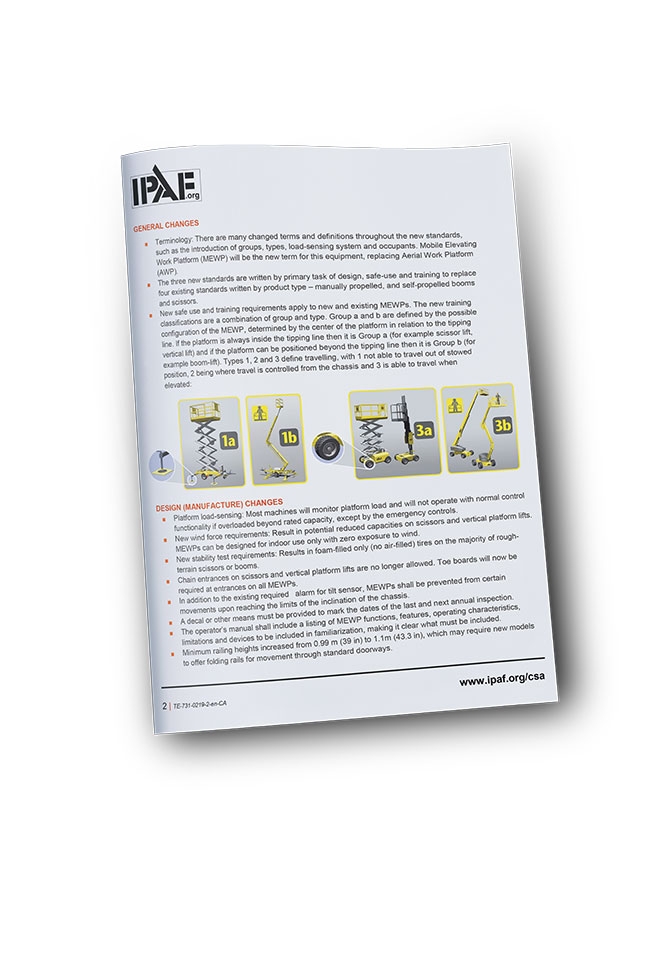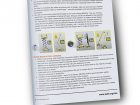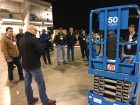
Lifting the standard – IPAF explains changes to CSA lift standards
By International Powered Access Federation
Associations News Government and regulatory technologyStandards are important and may establish standardized requirements for design of a product, process or system. They can specify performance of products or personnel. They can also define terms and definitions specific to the standard, so there is no misunderstanding among those using the standard.
 Lifts are grouped by CSA according to whether they travel stowed-only Standards are important
Lifts are grouped by CSA according to whether they travel stowed-only Standards are importantThe CSA B354 standards provide uniform guidance in the design and manufacturing of equipment. They also address the planning and operation for the safe-use of equipment and training requirements to aid users in achieving safe and effective use of the equipment. These standards assign responsibilities for various tasks to entities based on their roles as a manufacturer, dealer, rental operator, owner, user, operator and occupant. An individual or company may hold several roles; a user may also be an owner of a mobile elevating work platform (MEWP), resulting in responsibilities when acting in the role of an owner of the equipment and responsibilities of a user when as a user, authorizing employees to operate a MEWP.
Previously, CSA B354 standards requirements were specified by equipment classification: B354.1 for manually propelled platforms; B354.2 for scissor-type platforms and B354.4 for boom-type platforms. Each standard dictates requirements for design, safe-use and training to ensure the safe and effective use of each category of machine. These standards have been withdrawn.
IN WITH THE NEW
The new CAN/CSA B354 “MEWP Design, Safe-use and Training” suite of standards were recommended by the CSA B354 Technical Committee to be implemented by May 2018. The new standards are CSA B354.6: “MEWP – Design, calculations, safety requirements and test methods;” CSA B354.7: “MEWP – Safety principles, inspection, maintenance and operation;” and CSA B354.8: “MEWP – Operator (driver) training.” The design standard specifies design calculations and stability criteria, construction, safety examinations and tests and is predominately intended for manufacturers; the safe-use standard specifies requirements for application, inspection, training, maintenance, repair and safe operation of equipment and is predominantly intended for owners, users and operators; the training standard provides methods and guidelines to prepare MEWP training materials, defines administrative criteria and delivers elements required for proper training to implement the safe-use standard requirements and is predominantly intended for individuals or companies offering training.
The safe-use and training standards apply to both new and existing units and replace the inspections, maintenance, safe operating practices and operator training requirements of the CSA B354.1, B354.2 and B354.4 standards, which were withdrawn in 2018.
GENERAL CHANGES
There are many changed terms and definitions throughout the new standards, such as the introduction of groups, types, load-sensing system and occupants. Mobile Elevating Work Platform (MEWP) will be the new term for this equipment, replacing Aerial Work Platform (AWP). The three new standards are written by primary task of design, safe-use and training to replace four existing standards written by product type – manually propelled, and self-propelled booms and scissors. The new safe use and training requirements apply to new and existing MEWPs. The new training classifications are a combination of group and type. Group A and B are defined by the possible configuration of the MEWP, determined by the center of the platform in relation to the tipping line. If the platform is always inside the tipping line then it is group A (for example, scissor lift, vertical lift) and if the platform can be positioned beyond the tipping line then it is group B (for example, boom-lift). Types 1, 2 and 3 define travelling, with 1 not able to travel out of stowed position, 2 being where travel is controlled from the chassis and 3 is able to travel when elevated.
DESIGN CHANGES
Most machines will have to monitor platform load and will not operate with normal control functionality if overloaded beyond rated capacity, except by the emergency controls.
New wind force requirements will result in potential reduced capacities on scissors and vertical platform lifts. MEWPs can be designed for indoor use only with zero exposure to wind.
New stability test requirements will result in foam-filled only (no air-filled) tires on the majority of rough-terrain scissors or booms.
Chain entrances on scissors and vertical platform lifts are no longer allowed. Toe boards will now be required at entrances on all MEWPs.
In addition to the existing required alarm for the tilt sensor, MEWPs shall be prevented from certain movements upon reaching the limits of the inclination of the chassis.
A decal or other means must be provided to mark the dates of the last and next annual inspection.
The operator’s manual shall include a listing of MEWP functions, features, operating characteristics, limitations and devices to be included in familiarization, making it clear what must be included.
Minimum railing heights have been increased from 0.99 meters to 1.1 meters, which may require new models to offer folding rails for movement through standard doorways.
SAFE-USE CHANGES
Whenever a rental operator directs personnel to operate a MEWP (loading/unloading, inspecting, demonstrations or any form of use), the rental operator shall assume the responsibilities of users and must comply with all of the requirements of a user in the safe-use and training standards.
Requirements for modifications have been expanded to include more details concerning record keeping and communication (labels, instructions, serial plates). Modifications must only be performed if approved by the manufacturer or their successor, or, if they are no longer in business or it is not possible to obtain a response, an engineer.
Rental operators and owners must offer appropriate training and familiarization.
A “system of work” requires a program specific to MEWPs be developed by users to include tasks such as a risk assessment; the selection of the proper MEWP for the application; and access, preparation and maintenance of the work site in preparation for the use of the MEWP. As a rental operator assumes the role of a user anytime personnel are authorized as operators, all user responsibilities must be adhered to when acting as a user. A new requirement is performing a risk assessment to include identification of the task to be undertaken, selection of an appropriate MEWP, assessing risk, developing control measures and identifying safe work procedures. It is important to recognize this is required for all MEWP operations. A proper risk assessment requires a rescue plan for workers from an elevated platform. This includes planning a safe and timely rescue in case of MEWP malfunction or fall from the platform. Detailed guidance and requirements are provided for specific requirements of operation that address many known potential hazards such as wind, storms, ground conditions, transporting and travelling on public roads, to name but a few. These requirements must be considered in the risk assessment.
The requirement that exiting a MEWP at height shall only be permitted through a procedure provided by the manufacturer has been expanded to include “or in their absence an engineer.” The procedure must address detailed requirements defined in the standard. If the risk assessment determines that exiting at height is the safest method of work, then this procedure shall be followed when the exit at height is conducted. Rental operators must be knowledgeable to assist users and operators in meeting their requirements.
Electrical hazard avoidance offers new language to require users/operators to maintain the minimum safe approach distance (MSAD) from energized conductors at all times. A voltage chart with associated MSAD is provided in the standard. In the event the voltage is not known, the maximum distance shall be observed equal to 16 meters.
All users, including rental operators who have MEWP operators, must establish a system of work to monitor performance and to supervise the work of operators to ensure compliance with the standard requirements.
Re-training requirements now provide several examples when re-training would be necessary, such as an observed deterioration of proficiency or involvement in a near-miss or accident.
TRAINING CHANGES
Training delivered in the past that is compliant with previous standards will require supplemental training to address new requirements. Operator training is required for each MEWP classification. The training standard defines requirements for standardized training through methods and guidelines to prepare MEWP training materials, administrative criteria, and elements required for proper training and familiarization.
A rental operator acting as a user has the responsibility to ensure that operator of a MEWP is medically and physically fit to operate the MEWP safely. If a rental operator is offering training, they must ensure the user is aware of their responsibilities to select personnel who are qualified to perform the task and that the training offered meets the requirement that training provided is in a language that trainees can understand. The MEWP operator is required to provide instruction or otherwise ensure all occupants have a basic level of knowledge to work safely on the MEWP. This requirement must be covered in training courses. All users, to include rental operators who have MEWP operators, have many responsibilities and require qualified persons to complete them, such as risk assessments and operator evaluations. Consideration for personnel training to address user requirements to become qualified may be warranted. When delivering training, the trainer must comply with the requirement for administration of training to include training content, trainer and examiner qualification, examination and record keeping. There is a new requirement that theory (classroom/online) and practical (hands-on) evaluations to be documented. New annexes in the standard provide examples of theory and practical evaluation, MEWP operator cards and authorization-to-operate cards.
BECOMING COMPLIANT THROUGH IPAF TRAINING
The best way to ensure compliance is for operators to hold a Powered Access Licence (PAL) card and supervisors to complete IPAF’s MEWPs for Managers course. Utilizing the latest generation of online learning tools, IPAF offers operator trainees the option of completing the theory requirement of their training via interactive eLearning. The benefits of e-learning include:
- Trainees complete the module online – anytime, anywhere, on any device and at their own pace;
- Trainees can then complete the supervised hands-on practical test and evaluation at an approved training center to complete operator training;
- Operators don’t have to take so much time away from the job to complete training;
- In most cases necessary a hands-on practical test can be concluded comfortably inside a few hours;
- Trainees opting for an instructor-led theory course also benefit from sessions enhanced by the interactive material in the online module;
- Available in English or French.
For more information, please visit ipaf.org.
The International Powered Access Federation promotes the safe and effective use of powered access equipment worldwide in the widest sense – through providing technical advice and information; through influencing and interpreting legislation and standards; and through safety initiatives and training programmes. IPAF is a not-for-profit organisation owned by its members, which include manufacturers, rental companies, distributors, contractors and users. IPAF members operate a majority of the MEWP rental fleet worldwide and manufacture about 85 per cent of platforms on the market.
Print this page



Leave a Reply